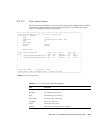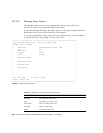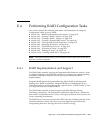
Appendix E Serial Attached SCSI BIOS Configuration Utility E-41
E.4 Performing RAID Configuration Tasks
This section contains the following information and instructions for using the
Configuration Utility to set up RAID:
■ Section E.4.1, “RAID Implementation and Support” on page E-41
■ Section E.4.2, “Creating a RAID 0 Volume” on page E-44
■ Section E.4.3, “Creating a RAID 1 Volume” on page E-45
■ Section E.4.5, “Creating a Second RAID Volume” on page E-46
■ Section E.4.6, “Viewing RAID Volume Properties” on page E-47
■ Section E.4.4, “Managing Hot Spares” on page E-46
■ Section E.4.7, “Synchronizing an Array” on page E-47
■ Section E.4.8, “Activating an Array” on page E-47
■ Section E.4.9, “Deleting an Array” on page E-48
■ Section E.4.10, “Locating a Disk Drive” on page E-48
Note – The RAID firmware needs at least 64 MB of unused disk space at the end of
each drive to store metadata.
E.4.1 RAID Implementation and Support
The LSISAS1064 controller supports the Integrated RAID hardware solution, which
is a highly integrated, low-cost RAID solution. It is designed for systems requiring
redundancy and high availability, but not requiring a full-featured RAID
implementation.
Integrated RAID includes Integrated Mirroring (IM or RAID 1) and Integrated
Striping (IS or RAID 0) technology. Integrated RAID is OS independent, easy to
install and configure, and does not require a special driver. A RAID Volume is seen
as a single drive by the host BIOS and OS.
The LSISAS1064 controller is based on the Fusion-MPT (Message Passing
Technology) architecture. The Fusion-MPT architecture requires only a thin device
driver that is independent of the I/O bus. LSI Logic provides the device drivers for
various operating environments.
The ILOM Service Processor monitors the GPIOs from the SAS1064 controller. If the
controller indicates a failure, the service processor lights the fault LED on the
corresponding disk drive and logs the error in the SP event log.


















